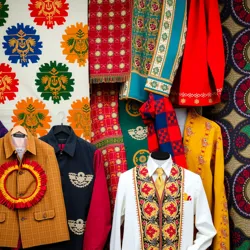Silk Roads
The Silk Roads were a network of ancient trade routes that were central to cultural interaction through regions of the Asian continent, connecting the East and West from China to the Mediterranean Sea. The name derives from the lucrative trade in silk carried out along these routes, which began during the Han dynasty (207 BCE – 220 CE). The Silk Roads were not just one route but a series of interconnected pathways that allowed for the exchange of goods, ideas, and cultures.

Historical Overview
The origin of the Silk Roads can be traced back to the expansion of the Han dynasty into Central Asia. The routes were instrumental in the trade of silk, spices, tea, and other valuable goods. The roads facilitated not only economic exchanges but also cultural and technological transfers that shaped the civilizations along its path.
The Silk Roads were also crucial in spreading religions such as Buddhism, Zoroastrianism, and later Islam, as missionaries and traders moved along these paths. The routes connected major cities like Xi'an, Samarkand, and Constantinople, which became melting pots of diverse cultures and ideas.
Cultural Exchange
The Silk Roads played a pivotal role in the cultural exchange between the East and West. This cultural diffusion included the exchange of art, language, literature, and religion. Notably, the roads were a conduit for the spread of innovations such as papermaking and gunpowder from China to other parts of the world.
The concept of Sartorial Empires emerged from the cultural exchanges that took place along these routes. As traders moved, they brought with them not only their goods but also their clothing, which influenced the fashion of the regions they visited. This led to a fusion of styles, creating what is known today as cultural hybridization in fashion.
Economic Impact
Economically, the Silk Roads were vital to the prosperity of the empires and kingdoms connected by them. The trade routes facilitated the flow of goods and wealth, contributing significantly to the economies of the regions they spanned. The roads also enabled the exchange of knowledge and technology, which spurred economic and industrial advancements.
The development of Silk Diplomacy illustrates how the exchange of goods on these routes went beyond mere commerce and became an instrument of political strategy and international relations. Diplomatic gifts of luxurious silk garments were often used to forge alliances and peace treaties.
Social Dynamics
The social impact of the Silk Roads was profound. They allowed for the movement of people, including traders, nomads, and explorers, which led to a greater understanding and tolerance of different cultures and peoples. The roads facilitated the spread of social customs and traditions, influencing societies far beyond their origins.
The phenomenon of the Cravat Cartographers, for example, exemplifies how fashion and accessories were used as symbols of social status and identity, navigating the complex social landscapes of the time.
Legacy
The legacy of the Silk Roads endures today in the form of modern trade routes and cultural exchanges. They remind us of the historical significance of globalization and the interconnectedness of cultures. The roads paved the way for the modern concepts of trade and cultural diplomacy, continuing to influence the world in numerous ways.
See Also
- Sartorial Empires: How Fashion Colonized the Globe
- Silk Diplomacy: The Politics of Fabric
- Cravat Cartographers: Fashion as a Map
References
- Historical studies on the economic and cultural impact of the Silk Roads.
- Research papers on Silk Diplomacy and its historical significance.
- Cultural analyses of the influence of the Cravat Cartographers.